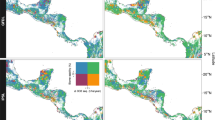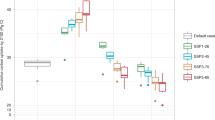Abstract
As one of Earth’s most carbon-dense regions, tropical forests are central to climate change mitigation efforts. Their unparalleled species richness also makes them vital for safeguarding biodiversity. However, because research has not been conducted at management-relevant scales and has often not accounted for forest disturbance, the biodiversity implications of carbon conservation strategies remain poorly understood. We investigated tropical carbon–biodiversity relationships and trade-offs along a forest-disturbance gradient, using detailed and extensive carbon and biodiversity datasets. Biodiversity was positively associated with carbon in secondary and highly disturbed primary forests. Positive carbon–biodiversity relationships dissipated at around 100 MgC ha–1, meaning that in less disturbed forests more carbon did not equal more biodiversity. Simulated carbon conservation schemes therefore failed to protect many species in the most species-rich forests. These biodiversity shortfalls were sensitive to opportunity costs and could be decreased for small carbon penalties. To ensure that the most ecologically valuable forests are protected, biodiversity needs to be incorporated into carbon conservation planning.
This is a preview of subscription content, access via your institution
Access options
Access Nature and 54 other Nature Portfolio journals
Get Nature+, our best-value online-access subscription
$29.99 / 30 days
cancel any time
Subscribe to this journal
Receive 12 print issues and online access
$209.00 per year
only $17.42 per issue
Buy this article
- Purchase on Springer Link
- Instant access to full article PDF
Prices may be subject to local taxes which are calculated during checkout




Similar content being viewed by others
References
Stern, N. H. The Economics of Climate Change: The Stern Review (Cambridge Univ. Press, Cambridge, 2007).
Global Biodiversity Outlook 4 (Convention on Biological Diversity, 2014).
Climate Research Roadmap Workshop: Summary Report (US Department of Energy Office of Science, 2010).
Dirzo, R. & Raven, P. H. Global state of biodiversity and loss. Annu. Rev. Environ. Resour. 28, 137–167 (2003).
Gullison, T. A. et al. Tropical forests and climate policy. Science 316, 985–986 (2007).
Gardner, T. A., Barlow, J., Sodhi, N. S. & Peres, C. A. A multi-region assessment of tropical forest biodiversity in a human-modified world. Biol. Conserv. 143, 2293–2300 (2010).
Parmesan, C. Ecological and evolutionary responses to recent climate change. Annu. Rev. Ecol. Evol. Syst. 37, 637–669 (2006).
Colwell, R. K. et al. Global warming, elevation range shifts, and lowland biotic attrition in the wet tropics. Science 322, 258–261 (2008).
Poorter, L. et al. Diversity enhances carbon storage in tropical forests. Glob. Ecol. Biogeogr. 24, 1314–1328 (2015).
Norman, M. & Nakhooda, S. The State of REDD+ Finance Working Paper 378 (Centre for Global Development, 2014).
McCarthy, D. P. et al. Financial costs of meeting global biodiversity conservation targets: current spending and unmet needs. Science 338, 946–949 (2012).
Seymour, F. & Busch, J. Why Forests? Why Now? The Science, Economics and Politics of Tropical Forests and Climate Change (Center for Global Development, Washington DC, 2016).
Asner, G. P. et al. A universal airborne LiDAR approach for tropical forest carbon mapping. Oecologia 168, 1147–1160 (2011).
Le Toan, T. et al. The BIOMASS mission: mapping global forest biomass to better understand the terrestrial carbon cycle. Remote Sens. Environ. 115, 2850–2860 (2011).
Gardner, T. A. et al. A framework for integrating biodiversity concerns into national REDD+ programmes. Biol. Conserv. 154, 61–71 (2011).
Phelps, J., Webb, E. L. & Adams, W. M. Biodiversity co-benefits of policies to reduce forest-carbon emissions. Nat. Clim. Change 2, 497–503 (2012).
Gilroy, J. J. et al. Cheap carbon and biodiversity co-benefits from forest regeneration in a hotspot of endemism. Nat. Clim. Change 4, 503–507 (2014).
Phelps, J., Friess, D. A. & Webb, E. L. Win-win REDD+ approaches belie carbon–biodiversity trade-offs. Biol. Conserv. 154, 53–60 (2012).
Strassburg, B. B. N. et al. Global congruence of carbon storage and biodiversity in terrestrial ecosystems. Conserv. Lett. 3, 98–105 (2010).
Cavanaugh, K. C. et al. Carbon storage in tropical forests correlates with taxonomic diversity and functional dominance on a global scale. Glob. Ecol. Biogeogr. 23, 563–573 (2014).
Beaudrot, L. et al. Limited carbon and biodiversity co-benefits for tropical forest mammals and birds. Ecol. Appl. 26, 1098–1111 (2016).
Gibson, L. et al. Primary forests are irreplaceable for sustaining tropical biodiversity. Nature 478, 378–381 (2011).
Lewis, S. L., Edwards, D. P. & Galbraith, D. Increasing human dominance of tropical forests. Science 349, 827–832 (2015).
Barlow, J. et al. Anthropogenic disturbance in tropical forests can double biodiversity loss from deforestation. Nature 535, 144–147 (2016).
Watson, J. E. M. et al. The exceptional value of intact forest ecosystems. Nat. Ecol. Evol. 2, 599–610 (2018).
Panfil, S. N. & Harvey, C. A. REDD+ and biodiversity conservation: a review of the biodiversity goals, monitoring methods, and impacts of 80 REDD+ projects. Conserv. Lett. 9, 143–150 (2016).
Grainger, A. et al. Biodiversity and REDD at Copenhagen. Curr. Biol. 19, R974–R976 (2009).
Magnago, L. F. S. et al. Would protecting tropical forest fragments provide carbon and biodiversity cobenefits under REDD+? Glob. Change Biol. 21, 3455–3468 (2015).
Chisholm, R. A. et al. Scale-dependent relationships between tree species richness and ecosystem function in forests. J. Ecol. 101, 1214–1224 (2013).
Sobral, M. et al. Mammal diversity influences the carbon cycle through trophic interactions in the Amazon. Nat. Ecol. Evol. 1, 1670–1676 (2017).
Dunn, R. R. Managing the tropical landscape: a comparison of the effects of logging and forest conversion to agriculture on ants, birds, and lepidoptera. For. Ecol. Manag. 191, 215–224 (2004).
Letcher, S. G. & Chazdon, R. L. Rapid recovery of biomass, species richness, and species composition in a forest chronosequence in Northeastern Costa Rica. Biotropica 41, 608–617 (2009).
Chazdon, R. L. et al. Rates of change in tree communities of secondary Neotropical forests following major disturbances. Phil. Trans. R. Soc. Lond. B 362, 273–289 (2007).
Barlow, J., Mestre, L. A. M., Gardner, T. A. & Peres, C. A. The value of primary, secondary and plantation forests for Amazonian birds. Biol. Conserv. 136, 212–231 (2007).
Aragão, L. E. O. C. et al. 21st century drought-related fires counteract the decline of Amazon deforestation carbon emissions. Nat. Commun. 9, 536 (2018).
Venter, O., Hovani, L., Bode, M. & Possingham, H. Acting optimally for biodiversity in a world obsessed with REDD+. Conserv. Lett. 6, 410–417 (2013).
Gardner, T. A. et al. A social and ecological assessment of tropical land uses at multiple scales: the Sustainable Amazon Network. Phil. Trans. R. Soc. Lond. B 368, 20120166 (2013).
Berenguer, E. et al. A large-scale field assessment of carbon stocks in human-modified tropical forests. Glob. Change Biol. 20, 3713–3726 (2014).
Ferraz, S. F. B., Vettorazzi, C. B. & Theobald, D. M. Using indicators of deforestation and land-use dynamics to support conservation strategies: a case study of central Rondônia, Brazil. For. Ecol. Manag. 257, 1589–1595 (2009).
Purvis, A., Gittleman, J. L., Cowlishaw, G. & Mace, G. M. Predicting extinction risk in declining species. Proc. Biol. Sci. 267, 1947–1952 (2000).
Harley, R. & Kuin, W. E. Scale dependency of rarity, extinction risk, and conservation priority. Cons. Biol. 17, 1559–1570 (2003).
Data Zone (BirdLife International, 2017); http://datazone.birdlife.org/home
King, D. A. et al. The role of wood density and stem support costs in the growth and mortality of tropical trees. J. Ecol. 94, 679–680 (2006).
Phillips, O. L. et al. Drought sensitivity of the Amazon rainforest. Science 323, 1344–1347 (2009).
Baker, T. R. et al. Variation in wood density determines spatial patterns in Amazonian forest biomass. Glob. Change Biol. 10, 545–562 (2004).
Zanne A. E. et al. Dryad Data from: Towards a worldwide wood economics spectrum. (Dryad Digital Repository, 2009); https://doi.org/10.5061/dryad.234
Lunn, D. J., Best, N. & Whittaker, J. C. Generic reversible jump MCMC using graphical models. Stat. Comput. 19, 395–408 (2009).
Thomson, J. R. et al. Bayesian change point analysis of abundance trends for pelagic fishes in the upper San Francisco Estuary. Ecol. Appl. 20, 1431–1448 (2010).
Brooks, S. P. & Gelman, A. General methods for monitoring convergence of iterative simulations. J. Comput. Graph. Stat. 7, 434–455 (1998).
Church, R. L., Stoms, D. M. & Davis, F. W. Reserve selection as a maximal covering location problem. Biol. Conserv. 76, 105–112 (1996).
Acknowledgements
We thank R. F. Braga, R. C. de Oliveira Jr, J. M. Silveira, F. Z. Vaz-de-Mello and R. C. S. Veiga for support with data collection, and R. A. Begotti, T. M. Cardoso, S. S. Nunes, J. V. Siqueira, C. M. Souza Jr and A. Venturieri for assistance processing the remotely sensed data. This work was supported by grants from Brazil (EMBRAPA SEG:02.08.06.005.00; CNPq 574008/2008-0, 458022/2013-6, 400640/2012-0 and PELD 441659/2016-0; CAPES scholarships; FAPESP 2012/51872-5; and The Nature Conservancy Brasil), the UK (Darwin Initiative 17-023; NE/F01614X/1; NE/G000816/1; NE/F015356/2; NE/l018123/1; NE/K016431/1; NE/N01250X/1, NE/N01250X/1; and H2020-MSCA-RISE-2015 (Project 691053-ODYSSEA)) and Formas 2013-1571, and Australian Research Council grant DP120100797. J.F. and R.P. acknowledge CNPq productivity scholarships (process numbers, respectively: 307788/2017-2 and 308205/2014-6). Institutional support was provided by the Herbário IAN in Belém and LBA in Santarém. This is paper number 66 in the Sustainable Amazon Network series.
Author information
Authors and Affiliations
Contributions
T.A.G., J.B. and J.F. designed the research, with input from E.B., A.C.L., S.F.B.F., J.L., V.H.F.O., R.R.C.S., I.C.G.V., L.E.O.C.A. and R.P. E.B., A.C.L., V.H.F.O., R.R.C.S., J.F., N.G.M. and J.L. collected the field data or analysed biological samples. S.F.B.F. and T.A.G. processed the remote sensing data. G.D.L. and J.R.T. analysed the data, with input from J.F., J.B., R.M.N., A.C.L. and T.A.G. G.D.L., J.F., J.B., T.A.G., A.C.L., R.M.N. and J.R.T. wrote the manuscript, with input from all authors.
Corresponding authors
Additional information
Publisher’s note: Springer Nature remains neutral with regard to jurisdictional claims in published maps and institutional affiliations.
Supplementary information
Supplementary Information
Supplementary Figures 1–6, Supplementary Tables 1 & 2
Rights and permissions
About this article
Cite this article
Ferreira, J., Lennox, G.D., Gardner, T.A. et al. Carbon-focused conservation may fail to protect the most biodiverse tropical forests. Nature Clim Change 8, 744–749 (2018). https://doi.org/10.1038/s41558-018-0225-7
Received:
Accepted:
Published:
Issue Date:
DOI: https://doi.org/10.1038/s41558-018-0225-7
This article is cited by
-
An empirical model for branding oriented by the environmental sustainability of the Amazon Rainforest: a hybrid structural equation modeling with fsQCA approach
Discover Analytics (2024)
-
Carbonservation with Demonstrated Biodiversity and Carbon Gains: Carbon Can Pay But Biodiversity Must Lead
Environmental Management (2024)
-
Impact of small farmers' access to improved seeds and deforestation in DR Congo
Nature Communications (2023)
-
High economic costs of reduced carbon sinks and declining biome stability in Central American forests
Nature Communications (2023)
-
Contrasting Responses of Soil Nematode Trophic Groups to Long-Term Nitrogen Addition
Ecosystems (2023)



